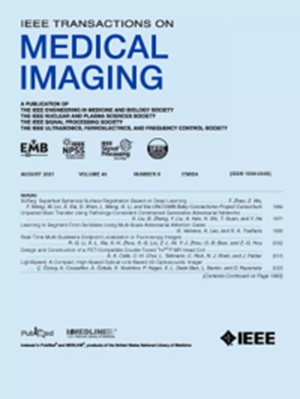Frenet-Serret Frame-based Decomposition for Part Segmentation of 3D Curvilinear Structures.
IF 9.8
1区 医学
Q1 COMPUTER SCIENCE, INTERDISCIPLINARY APPLICATIONS
引用次数: 0
Abstract
Accurate segmentation of anatomical substructures within 3D curvilinear structures in medical imaging remains challenging due to their complex geometry and the scarcity of diverse, large-scale datasets for algorithm development and evaluation. In this paper, we use dendritic spine segmentation as a case study and address these challenges by introducing a novel Frenet-Serret Framebased Decomposition, which decomposes 3D curvilinear structures into a globally smooth continuous curve that captures the overall shape, and a cylindrical primitive that encodes local geometric properties. This approach leverages Frenet-Serret Frames and arc length parameterization to preserve essential geometric features while reducing representational complexity, facilitating data-efficient learning, improved segmentation accuracy, and generalization on 3D curvilinear structures. To rigorously evaluate our method, we introduce two datasets: CurviSeg, a synthetic dataset for 3D curvilinear structure segmentation that validates our method's key properties, and DenSpineEM, a benchmark for dendritic spine segmentation, which comprises 4,476 manually annotated spines from 70 dendrites across three public electron microscopy datasets, covering multiple brain regions and species. Our experiments on DenSpineEM demonstrate exceptional cross-region and cross-species generalization: models trained on the mouse somatosensory cortex subset achieve 94.43% Dice, maintaining strong performance in zero-shot segmentation on both mouse visual cortex (95.61% Dice) and human frontal lobe (86.63% Dice) subsets. Moreover, we test the generalizability of our method on the IntrA dataset, where it achieves 77.08% Dice (5.29% higher than prior arts) on intracranial aneurysm segmentation from entire artery models. These findings demonstrate the potential of our approach for accurately analyzing complex curvilinear structures across diverse medical imaging fields. Our dataset, code, and models are available at https://github.com/VCG/FFD4DenSpineEM to support future research.基于Frenet-Serret框架的三维曲线结构零件分割。
由于其复杂的几何形状以及用于算法开发和评估的各种大规模数据集的稀缺,医学成像中三维曲线结构中解剖子结构的准确分割仍然具有挑战性。在本文中,我们以树突脊柱分割为例进行研究,并通过引入一种新颖的基于Frenet-Serret帧的分解来解决这些挑战,该分解方法将3D曲线结构分解为捕获整体形状的全局光滑连续曲线和编码局部几何属性的圆柱形原语。该方法利用Frenet-Serret框架和弧长参数化来保留基本的几何特征,同时降低表征复杂性,促进数据高效学习,提高分割精度,并对3D曲线结构进行泛化。为了严格评估我们的方法,我们引入了两个数据集:CurviSeg,一个用于3D曲线结构分割的合成数据集,验证了我们的方法的关键属性;DenSpineEM,一个树突脊柱分割的基准数据集,包括来自三个公共电子显微镜数据集的70个树突的4,476个手动注释的脊柱,涵盖多个大脑区域和物种。我们在DenSpineEM上的实验证明了卓越的跨区域和跨物种泛化:在小鼠体感皮层子集上训练的模型达到了94.43%的Dice,在小鼠视觉皮层(95.61% Dice)和人类额叶(86.63% Dice)子集上保持了良好的零射击分割性能。此外,我们在IntrA数据集上测试了我们的方法的泛化性,从整个动脉模型中分割颅内动脉瘤的准确率达到77.08%(比现有技术高5.29%)。这些发现证明了我们的方法在不同医学成像领域准确分析复杂曲线结构的潜力。我们的数据集、代码和模型可在https://github.com/VCG/FFD4DenSpineEM上获得,以支持未来的研究。
本文章由计算机程序翻译,如有差异,请以英文原文为准。
求助全文
约1分钟内获得全文
求助全文
来源期刊

IEEE Transactions on Medical Imaging
医学-成像科学与照相技术
CiteScore
21.80
自引率
5.70%
发文量
637
审稿时长
5.6 months
期刊介绍:
The IEEE Transactions on Medical Imaging (T-MI) is a journal that welcomes the submission of manuscripts focusing on various aspects of medical imaging. The journal encourages the exploration of body structure, morphology, and function through different imaging techniques, including ultrasound, X-rays, magnetic resonance, radionuclides, microwaves, and optical methods. It also promotes contributions related to cell and molecular imaging, as well as all forms of microscopy.
T-MI publishes original research papers that cover a wide range of topics, including but not limited to novel acquisition techniques, medical image processing and analysis, visualization and performance, pattern recognition, machine learning, and other related methods. The journal particularly encourages highly technical studies that offer new perspectives. By emphasizing the unification of medicine, biology, and imaging, T-MI seeks to bridge the gap between instrumentation, hardware, software, mathematics, physics, biology, and medicine by introducing new analysis methods.
While the journal welcomes strong application papers that describe novel methods, it directs papers that focus solely on important applications using medically adopted or well-established methods without significant innovation in methodology to other journals. T-MI is indexed in Pubmed® and Medline®, which are products of the United States National Library of Medicine.
 求助内容:
求助内容: 应助结果提醒方式:
应助结果提醒方式:


